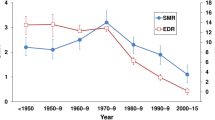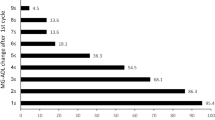Abstract
Background
The monocyte-derived cytokine, tumor necrosis factor α (TNFα), is essential for host immunity, but overproduction of this cytokine may have serious pathologic consequences. Excess TNFα produced in pulmonary tuberculosis may cause fevers, weakness, night sweats, necrosis, and progressive weight loss. Thalidomide (α-N-phthalimidoglutarimide) has recently been shown to suppress TNFα production by human monocytes in vitro and to reduce serum TNFα in leprosy patients. We have therefore conducted a two-part placebo-controlled pilot study of thalidomide in patients with active tuberculosis to determine its effects on clinical response, immune reactivity, TNFα levels, and weight.
Materials and Methods
30 male patients with active tuberculosis, either human immunodeficiency virus type 1 positive (HIV-1+) or HIV-1−, received thalidomide or placebo for single or multiple 14 day cycles. Toxicity of the study drug, delayed type hypersensitivity (DTH), cytokine production, and weight gain were evaluated.
Results
Thalidomide treatment was well tolerated, without serious adverse events. The drug did not adversely affect the DTH response to purified protein derivative (PPD), total leukocyte, or differential cell counts. TNFα production was significantly reduced during thalidomide treatment while interferon-γ (IFNγ) production was enhanced. Daily administration of thalidomide resulted in a significant enhancement of weight gain.
Conclusions
The results indicate that thalidomide is well tolerated by patients receiving anti-tuberculosis therapy. Thalidomide treatment reduces TNFα production both in vivo and in vitro and is associated with an accelerated weight gain during the study period.






Similar content being viewed by others
References
Beutler B, Cerami A. (1988) The biology of cachectin-TNF: A primary mediator of the host response. Annu. Rev. Immunol 7: 625–655.
Barnes PF, Fong S-J, Brennan PF, Twomey PE, Mazumder A, Modlin RL. (1990) Local production of tumor necrosis factor and IFN-gamma in tuberculous pleuritis. J. Immunol. 145: 149–154.
Takashima T, Ueta C, Tsuyuguchi I, Kishimoto S. (1990) Production of tumor necrosis factor alpha by monocytes from patients with pulmonary tuberculosis. Infect. Immun. 58: 3286–3292.
Ogawa T, Uchida H, Kusumoto Y, Mori Y, Yamamura Y, Hamada S. (1991) Increase in tumor necrosis factor alpha- and interleukin-6-secreting cells in peripheral blood mononuclear cells from subjects infected with Mycobacterium tuberculosis. Infect. Immun. 59: 3021–3025.
Valone SE, Rich EA, Wallis RS, Ellner JJ. (1988) Expression of tumor necrosis factor in vitro by human mononuclear phagocytes stimulated with whole Mycobacterium bovis BCG and mycobacterial antigens. Infect. Immun. 56: 3313–3315.
Kindler V, Sappino A-P, Grau GE, Piguet P-F, Vassalli P. (1989) The inducing role of tumor necrosis factor in the development of bactericidal granulomas during BCG infection. Cell 56: 731–740.
Havell EA. (1989) Evidence that tumor necrosis factor has an important role in antibacterial resistance. J. Immunol. 143: 2894–2899.
North RJ, Izzo A. (1993) Granuloma formation in severe combined immunodeficient (SCID) mice in response to progressive BCG infection. Am. J. Pathol. 142: 1959–1966.
Tracey KJ, Wei H, Manogue KR, et al. (1989) Cachectin/tumor necrosis factor induces cachexia anemia and inflammation. J. Exp. Med. 167: 1211–1227.
Cotran RS, Kumar V, Robbins SL (eds). (1989) Pathologic Basis of Disease. 4th Ed. W. B. Saunders, Philadelphia.
van der Poll T, Jansen J, van Leenen D, et al. (1993) Release of soluble receptors for tumor necrosis factor in clinical sepsis and experimental endotoxemia. J. Infect. Dis. 168: 955–960.
Sampaio EP, Kaplan G, Miranda A, et al. (1993) The influence of thalidomide on the clinical and immunologic manifestation of erythema nodosum leprosum. J. Infect. Dis. 168: 408–414.
Sampaio EP, Sarno EN, Gallily R, Cohn ZA, Kaplan G. (1991) Thalidomide selectively inhibits TNFα production by stimulated human monocytes. J. Exp. Med. 173: 699–703.
Sarno EN, Grau GE, Vieira LMM, Nery JA. (1991) Serum levels of tumour necrosis factor-alpha and interleukin-1 beta during leprosy reactional states. Clin. Exp. Immunol. 84: 103–108.
Moreira AL, Sampaio EP, Zmuidzinas A, Frindt P, Smith KA, Kaplan G. (1993) Thalidomide exerts its inhibitory action on tumor necrosis factor-α by enhancing mRNA degradation. J. Exp. Med. 177: 1675–1680.
Aukrust P, Liabakk N-B, Muller F, Lien E, Espevik T, Froland SS. (1994) Serum levels of tumor necrosis factor-α (TNFα) and soluble TNF receptors in human immunodeficiency virus type 1 infection-correlation to clinical, immunologic, and virologic parameters. J. Infect. Dis. 169: 420–424.
Johnson BJ, McMurray D. (1994) Cytokine gene expression by cultures of human lymphocytes with autologous Mycobacterium tuberculosis-infected monocytes. Infect. Immun. 62: 1444–1450.
Makonkawkeyoon S, Limson-Pobre RNR, Moreira AL, Schauf V, Kaplan G. (1993) Thalidomide inhibits the replication of human immunodeficiency virus type 1. Proc. Natl. Acad. Sci. U.S.A. 90: 5974–5978.
Acknowledgments
We thank the nurses Sumalee Ammarinsangpen, Jinda Tongsuradet and Amporn Suwanprasert, from the Chiang Mai tuberculosis control center, for making this study possible. Dr. Attapon Cheepsatayakorn is acknowledged for help with the radiology. We also thank Cynthia Seidman, Dacia Vasquez, and Jolanta Diakun from the Dietary Service at the Rockefeller University GCRC, and the nurses and staff of the Rockefeller University Hospital; Marguerite Nulty for typing the manuscript; Judy Adams for help with the figures; and Jason Tian for help with the statistical analysis. Dr. Victoria Schauf helped initiate these studies. Dr. Victoria Freedman’s help in writing the manuscript is gratefully acknowledged. This study was supported in part by U.S. Public Health Service Grants AI 24775, AI 33124, and AI 07012, a Rockefeller University General Clinical Research Center Grant (MO1-RR00102), Grunenthal GMBH, and Celgene Corporation.
Author information
Authors and Affiliations
Rights and permissions
About this article
Cite this article
Tramontana, J.M., Utaipat, U., Molloy, A. et al. Thalidomide Treatment Reduces Tumor Necrosis Factor α Production and Enhances Weight Gain in Patients with Pulmonary Tuberculosis. Mol Med 1, 384–397 (1995). https://doi.org/10.1007/BF03401576
Published:
Issue Date:
DOI: https://doi.org/10.1007/BF03401576




